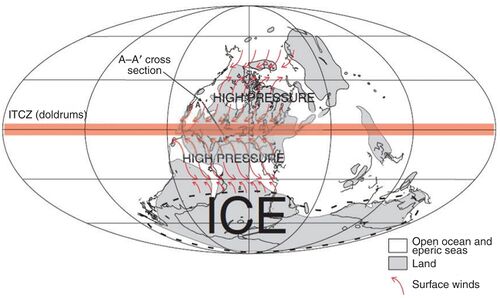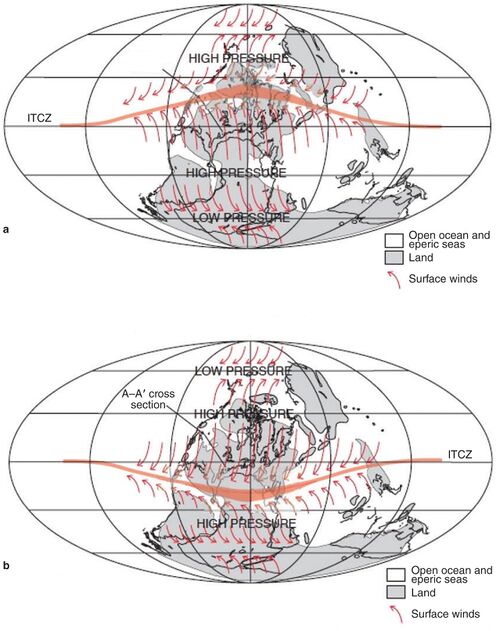Galatia Channel:Linkage of Climate and Eustasy
Linkage of Climate and Eustasy
We have alluded to changes in climate, together with fluctuating sea level, as being instrumental in the evolution of the Galatia channel and its related features. The recurrent glacial episodes that induced sea-level changes affected climate in the tropical realm of peat production as well as in the polar and temperate realms. Here we explore how and why climate and sea-level changes were linked.
Earth’s climate belts of today are the products of unequal solar energy to the earth’s surface. Solar radiation is most intense in the tropics, where the sun is directly overhead. Hot air rises in a belt that girdles the earth roughly parallel to the equator. Rising air, heavily laden with moisture, cools as it rises, producing clouds and heavy rainfall. This rainy tropical belt of rising air is called the intertropical convergence zone (ITCZ). In more familiar terms, this is the doldrums, that zone of light and fickle winds where sailing ships often lay becalmed for weeks at a time. The ITCZ is also a belt of low pressure that draws air from both north and south, setting up persistent winds that angle toward the equator—the trade winds. Beyond them lie the horse latitudes, which, like the doldrums, are belts of persistent high pressure, light and variable winds, and dry weather (Figures 59 and 60). Most of the earth’s largest deserts fall in the horse latitudes.
 Figure 59 Conceptual model of Pangea during a glacial episode of the Pennsylvanian. From Cecil, C.B., F.T. Dulong, R.R. West, R. Stamm, B. Wardlaw, and N.T. Edgar, 2003b, Climate controls on the stratigraphy of a Middle Pennsylvanian cyclothem in North America, in C.B. Cecil and N.T. Edgar, eds., Climate controls on stratigraphy: SEPM Special Publication 77, p. 151–180. Copyright © 2003, used with permission of SEPM; permission conveyed through Copyright Clearance Center, Inc. ITCZ, intertropical convergence zone.
Figure 59 Conceptual model of Pangea during a glacial episode of the Pennsylvanian. From Cecil, C.B., F.T. Dulong, R.R. West, R. Stamm, B. Wardlaw, and N.T. Edgar, 2003b, Climate controls on the stratigraphy of a Middle Pennsylvanian cyclothem in North America, in C.B. Cecil and N.T. Edgar, eds., Climate controls on stratigraphy: SEPM Special Publication 77, p. 151–180. Copyright © 2003, used with permission of SEPM; permission conveyed through Copyright Clearance Center, Inc. ITCZ, intertropical convergence zone. Figure 60 Conceptual model of Pangea during an interglacial episode of the Pennsylvanian. From Cecil, C.B., F.T. Dulong, R.R. West, R. Stamm, B. Wardlaw, and N.T. Edgar, 2003b, Climate controls on the stratigraphy of a Middle Pennsylvanian cyclothem in North America, in C.B. Cecil and N.T. Edgar, eds., Climate controls on stratigraphy: SEPM Special Publication 77, p. 151–180. Copyright © 2003, used with permission of SEPM; permission conveyed through Copyright Clearance Center, Inc. ITCZ, intertropical convergence zone.
Figure 60 Conceptual model of Pangea during an interglacial episode of the Pennsylvanian. From Cecil, C.B., F.T. Dulong, R.R. West, R. Stamm, B. Wardlaw, and N.T. Edgar, 2003b, Climate controls on the stratigraphy of a Middle Pennsylvanian cyclothem in North America, in C.B. Cecil and N.T. Edgar, eds., Climate controls on stratigraphy: SEPM Special Publication 77, p. 151–180. Copyright © 2003, used with permission of SEPM; permission conveyed through Copyright Clearance Center, Inc. ITCZ, intertropical convergence zone.
The doldrums (ITCZ), trade winds, and horse latitudes follow the sun through the seasons, migrating north during the summer[footnote 1] and south in winter. The result is that many areas of the tropics receive distinct wet and dry seasons. Wet seasons or monsoons, characterized by torrential downpours, take place when the ITCZ is overhead. Monsoons alternate with hot, dry seasons when little rain falls. Depending on the local geography, areas of the tropics may receive either one or two annual monsoons, whereas other places have an ever-wet (or perhumid) climate, under which rainfall exceeds evapotranspiration every month of the year.
In the modern world, cold, dense air settles over the poles and flows outward, displacing warm, moist air and generating storms in the middle latitudes. During the “ice ages,” the polar realm expanded greatly, compressing the earth’s other climate belts toward the equator. As a result, the ICTZ did not migrate as freely with the seasons as it does during the current interglacial episode. With the ITCZ nearly fixed in place during glacial episodes, much of the equatorial region experienced an ever-wet climate.
Platetectonic reconstructions indicate that during the Pennsylvanian, the coal-forming regions of the Illinois and Appalachian Basins, maritime Canada, Western Europe, Russia, and the Ukraine were all aligned close to the equator. Thus, a number of authors (Cecil et al. 2003a[1], 2003b[2]; Peyser and Poulsen 2008[3]; Eros et al. 2012[4]; Horton et al. 2012[5]) deduced the following equation:
Maximum glacial ice = Low sea level = Ever-wet climate = Maximum peat production.
Conversely, during the interglacial episodes, the sea level rose and a monsoonal regime of pronounced wet and dry seasons took hold. Less vegetation stabilized the landscape because fewer plants could tolerate the extended annual droughts. Hence, soil erosion and the sediment load in streams increased dramatically compared with the episodes of ever-wet climate, when plants carpeted the landscape:
Minimum glacial ice = High sea level = Strong wet–dry seasonal climate = Maximum erosion and runoff.
Notes
- ↑ For simplicity, seasons are discussed in northern hemisphere terms.
Primary Source
References
- ↑ Cecil, C.B., F.T. Dulong, R.A. Harris, J.C. Cobb, H.J. Gluskoter, and H. Nugroho, 2003a, Observations on climate and sediment discharge in selected tropical rivers, Indonesia, in C.B. Cecil and N.T. Edgar, eds., Climate controls on stratigraphy: SEPM (Society for Sedimentary Geology), Special Publication 77, p. 29–50, https://doi.org/10.2110/pec.03.77.0029.
- ↑ Cecil, C.B., F.T., Dulong, R.R. West, R. Stamm, B. Wardlaw, and N.T. Edgar, 2003b, Climate controls on the stratigraphy of a Middle Pennsylvanian cyclothem in North America, in C.B. Cecil and N.T. Edgar, eds., Climate controls on stratigraphy: SEPM (Society for Sedimentary Geology) Special Publication 77, p. 151–180, https://doi.org/10.2110/pec.03.77.0151.
- ↑ Peyser, C.E., and C.J. Poulsen, 2008, Controls on Permo-Carboniferous precipitation over tropical Pangaea: A GCM sensitivity study: Palaeogeography, Palaeoclimatology, Palaeoecology, v. 268, p. 181–192.
- ↑ Eros, J.M., I.P. Montañez, D.A. Osleger, V.I. Davydov, T.I. Nemyrovska, V.I. Poletaev, and M.V. Zhykalyak, 2012, Sequence stratigraphy and onlap history of the Donets Basin, Ukraine: Insight into Carboniferous icehouse dynamics: Palaeogeography, Palaeoclimatology, Palaeoecology, v. 313– 314, p. 1–25.
- ↑ Horton, D.E., C.J. Poulsen, I.P. Montañez, and W.A. DiMichele, 2012, Eccentricity-paced late Paleozoic climate change: Palaeogeography, Palaeoclimatology, Palaeoecology, v. 331–332, p. 150–161.